Comprehensive Nursing Care: Clinical Assessment Report
VerifiedAdded on 2021/06/17
|17
|4874
|199
Report
AI Summary
This report provides a detailed analysis of comprehensive nursing care, focusing on a case study of a 5-year-old girl named Mary diagnosed with Ewing's sarcoma. The assignment explores the importance of confidentiality, informed decision-making, and adherence to nursing standards, as outlined by the Nursing and Midwifery Board of Australia (NMBA). The report includes a clinical assessment, utilizing both the HEADSS and ABCDE approaches to evaluate the patient's condition. The scenario details Mary's symptoms, diagnostic tests, and treatment plan, emphasizing the challenges faced by a single-parent family. The assessment covers airway, breathing, circulation, disability, and exposure, as well as health priorities, highlighting the significance of addressing the patient's physical and emotional needs. The report emphasizes the importance of a compassionate and holistic approach to patient care, considering the patient's home environment, educational status, and potential for psychological distress. The report also analyzes the various clinical tests and their results, and concludes with an overview of the patient's condition and the required nursing interventions. The assignment highlights the complexities of pediatric oncology nursing and the need for comprehensive care in managing the disease and its impact on the patient and her family.
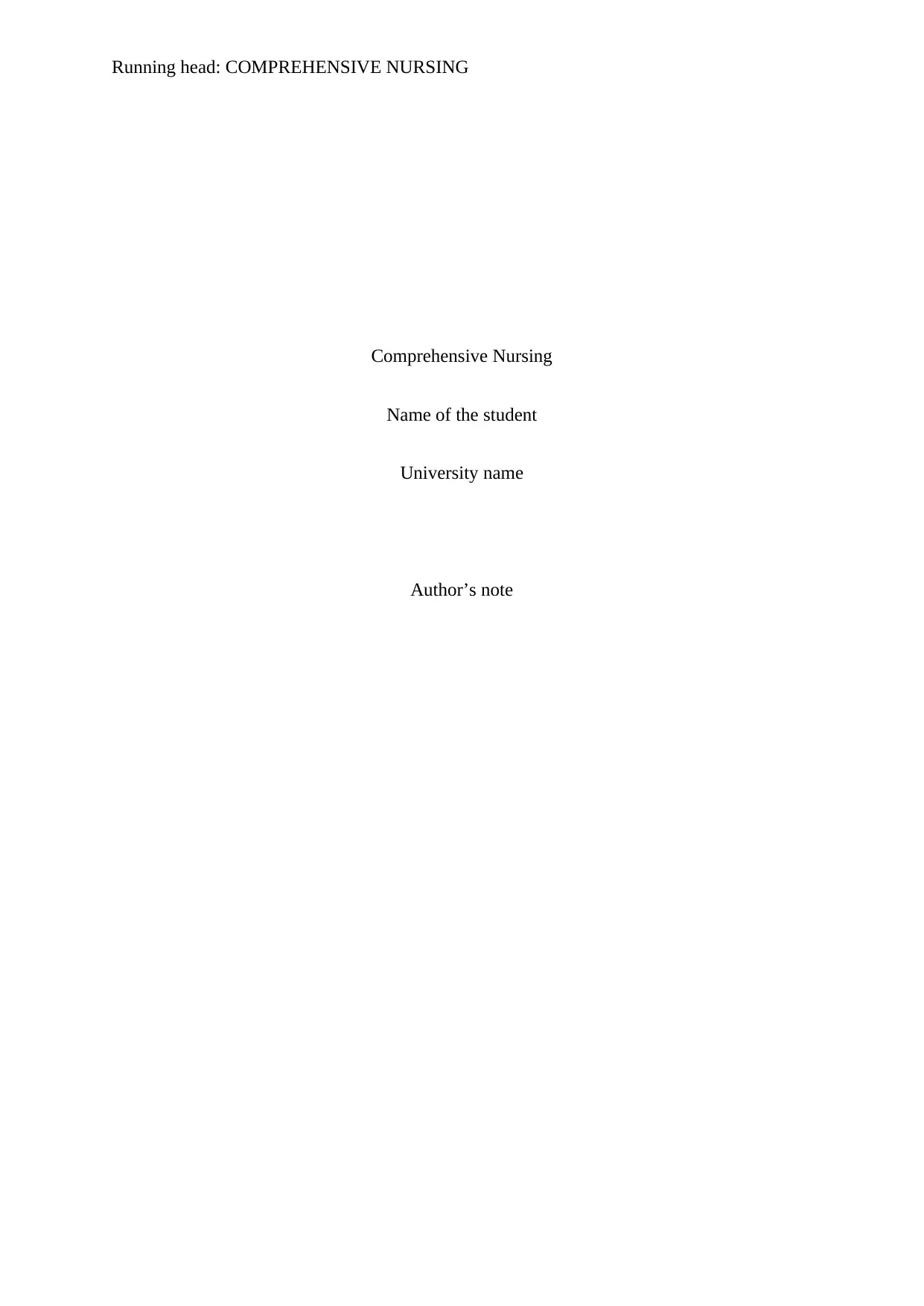
Running head: COMPREHENSIVE NURSING
Comprehensive Nursing
Name of the student
University name
Author’s note
Comprehensive Nursing
Name of the student
University name
Author’s note
Paraphrase This Document
Need a fresh take? Get an instant paraphrase of this document with our AI Paraphraser
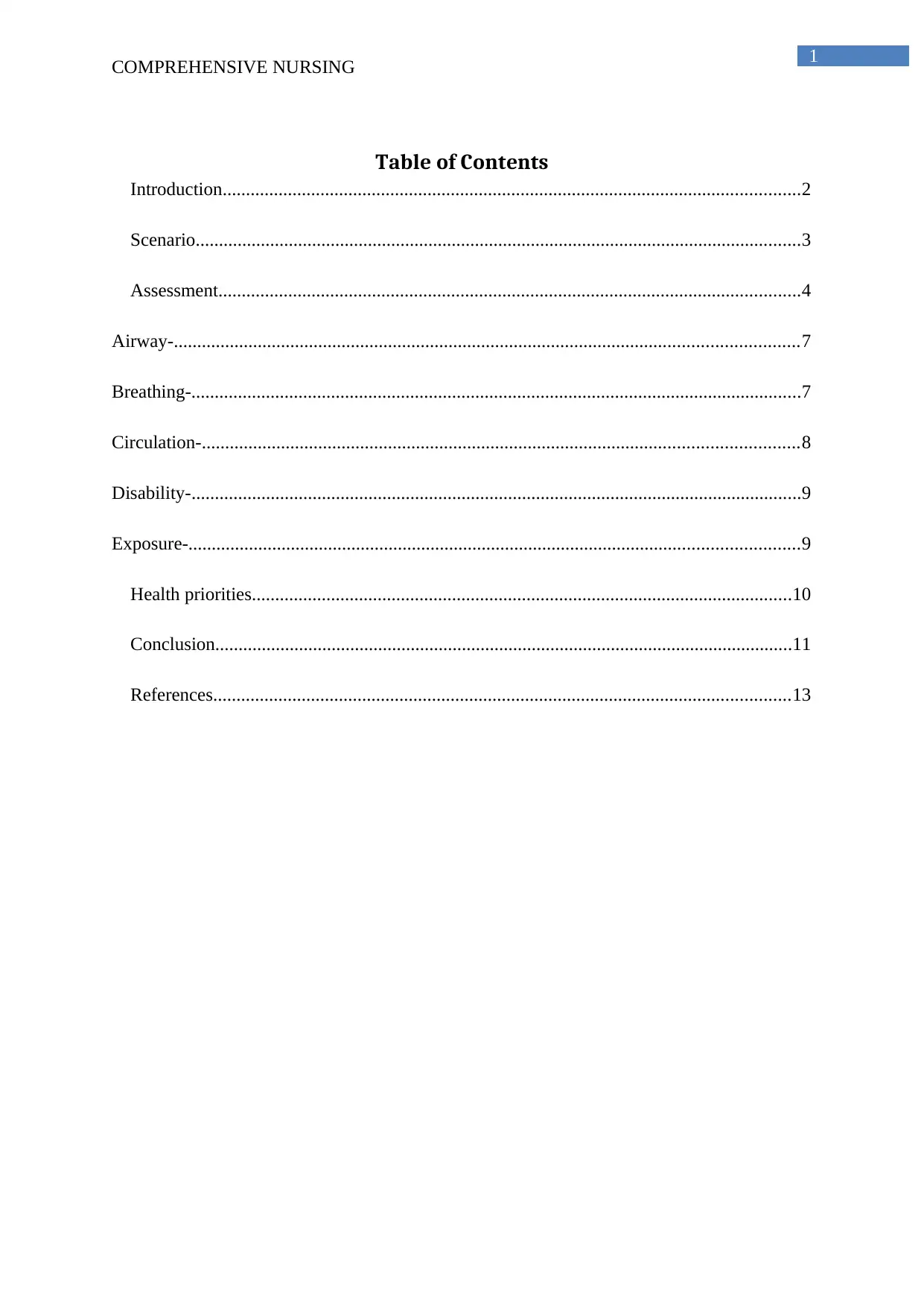
1
COMPREHENSIVE NURSING
Table of Contents
Introduction............................................................................................................................2
Scenario..................................................................................................................................3
Assessment.............................................................................................................................4
Airway-......................................................................................................................................7
Breathing-...................................................................................................................................7
Circulation-................................................................................................................................8
Disability-...................................................................................................................................9
Exposure-...................................................................................................................................9
Health priorities....................................................................................................................10
Conclusion............................................................................................................................11
References............................................................................................................................13
COMPREHENSIVE NURSING
Table of Contents
Introduction............................................................................................................................2
Scenario..................................................................................................................................3
Assessment.............................................................................................................................4
Airway-......................................................................................................................................7
Breathing-...................................................................................................................................7
Circulation-................................................................................................................................8
Disability-...................................................................................................................................9
Exposure-...................................................................................................................................9
Health priorities....................................................................................................................10
Conclusion............................................................................................................................11
References............................................................................................................................13
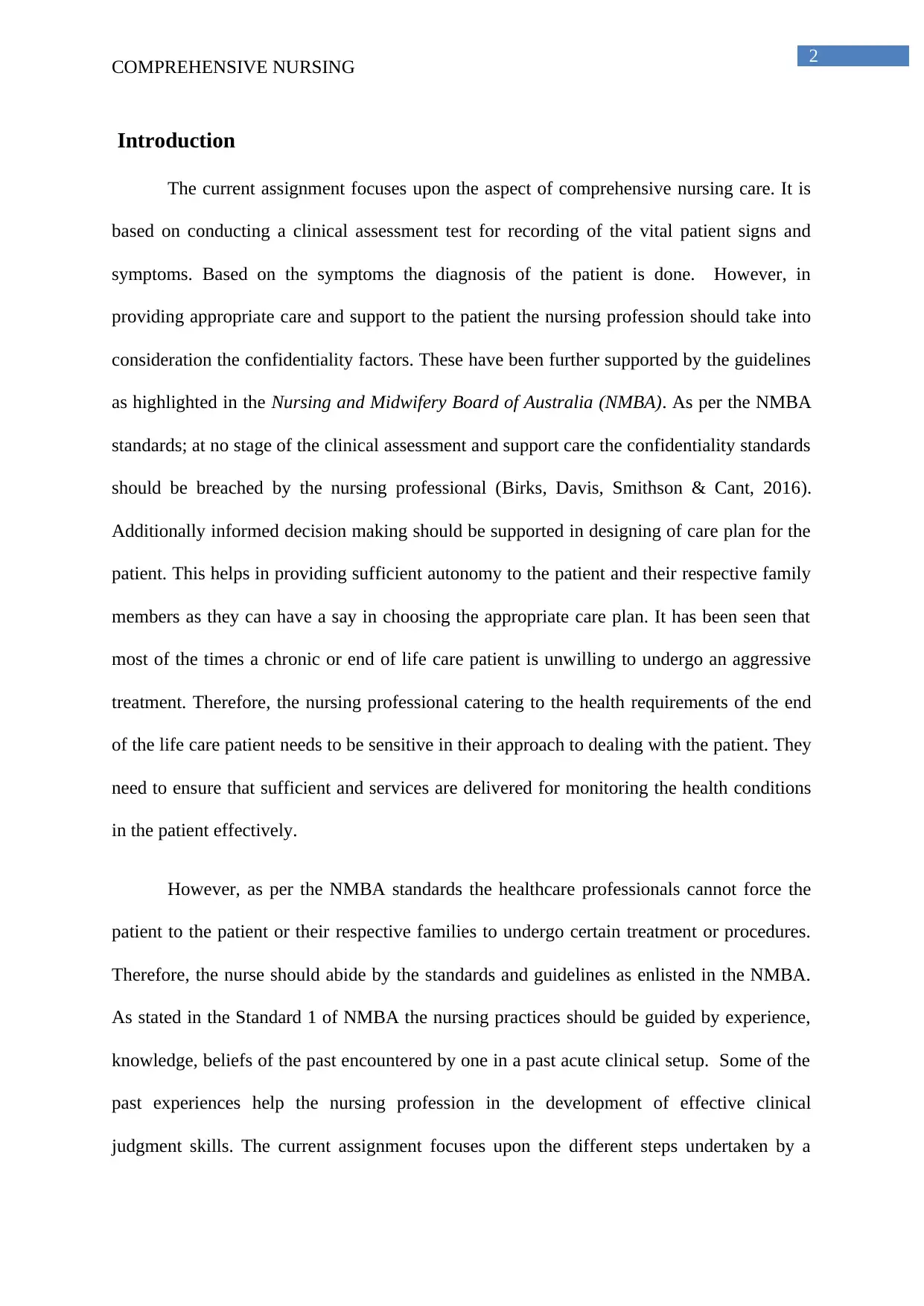
2
COMPREHENSIVE NURSING
Introduction
The current assignment focuses upon the aspect of comprehensive nursing care. It is
based on conducting a clinical assessment test for recording of the vital patient signs and
symptoms. Based on the symptoms the diagnosis of the patient is done. However, in
providing appropriate care and support to the patient the nursing profession should take into
consideration the confidentiality factors. These have been further supported by the guidelines
as highlighted in the Nursing and Midwifery Board of Australia (NMBA). As per the NMBA
standards; at no stage of the clinical assessment and support care the confidentiality standards
should be breached by the nursing professional (Birks, Davis, Smithson & Cant, 2016).
Additionally informed decision making should be supported in designing of care plan for the
patient. This helps in providing sufficient autonomy to the patient and their respective family
members as they can have a say in choosing the appropriate care plan. It has been seen that
most of the times a chronic or end of life care patient is unwilling to undergo an aggressive
treatment. Therefore, the nursing professional catering to the health requirements of the end
of the life care patient needs to be sensitive in their approach to dealing with the patient. They
need to ensure that sufficient and services are delivered for monitoring the health conditions
in the patient effectively.
However, as per the NMBA standards the healthcare professionals cannot force the
patient to the patient or their respective families to undergo certain treatment or procedures.
Therefore, the nurse should abide by the standards and guidelines as enlisted in the NMBA.
As stated in the Standard 1 of NMBA the nursing practices should be guided by experience,
knowledge, beliefs of the past encountered by one in a past acute clinical setup. Some of the
past experiences help the nursing profession in the development of effective clinical
judgment skills. The current assignment focuses upon the different steps undertaken by a
COMPREHENSIVE NURSING
Introduction
The current assignment focuses upon the aspect of comprehensive nursing care. It is
based on conducting a clinical assessment test for recording of the vital patient signs and
symptoms. Based on the symptoms the diagnosis of the patient is done. However, in
providing appropriate care and support to the patient the nursing profession should take into
consideration the confidentiality factors. These have been further supported by the guidelines
as highlighted in the Nursing and Midwifery Board of Australia (NMBA). As per the NMBA
standards; at no stage of the clinical assessment and support care the confidentiality standards
should be breached by the nursing professional (Birks, Davis, Smithson & Cant, 2016).
Additionally informed decision making should be supported in designing of care plan for the
patient. This helps in providing sufficient autonomy to the patient and their respective family
members as they can have a say in choosing the appropriate care plan. It has been seen that
most of the times a chronic or end of life care patient is unwilling to undergo an aggressive
treatment. Therefore, the nursing professional catering to the health requirements of the end
of the life care patient needs to be sensitive in their approach to dealing with the patient. They
need to ensure that sufficient and services are delivered for monitoring the health conditions
in the patient effectively.
However, as per the NMBA standards the healthcare professionals cannot force the
patient to the patient or their respective families to undergo certain treatment or procedures.
Therefore, the nurse should abide by the standards and guidelines as enlisted in the NMBA.
As stated in the Standard 1 of NMBA the nursing practices should be guided by experience,
knowledge, beliefs of the past encountered by one in a past acute clinical setup. Some of the
past experiences help the nursing profession in the development of effective clinical
judgment skills. The current assignment focuses upon the different steps undertaken by a
⊘ This is a preview!⊘
Do you want full access?
Subscribe today to unlock all pages.

Trusted by 1+ million students worldwide
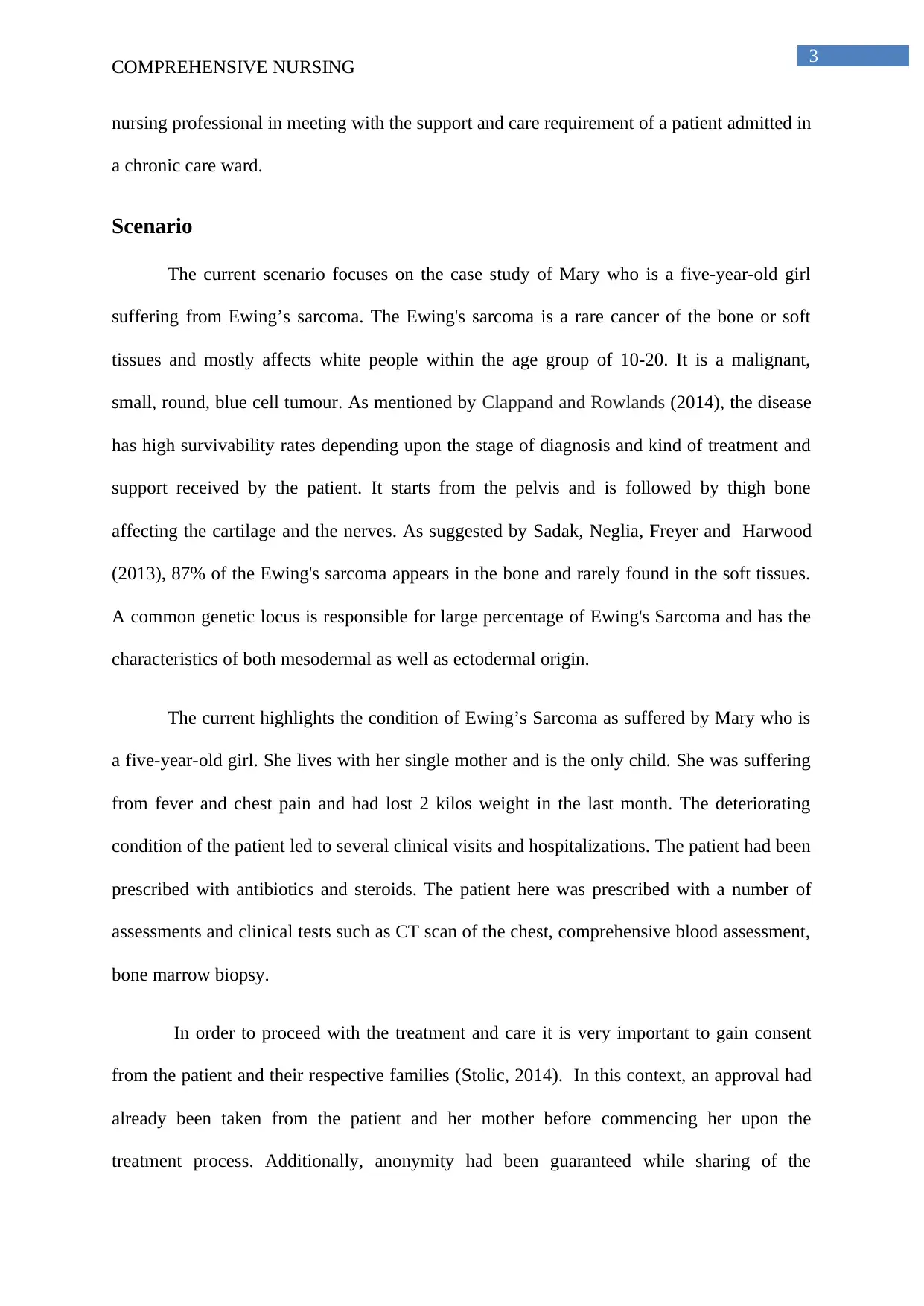
3
COMPREHENSIVE NURSING
nursing professional in meeting with the support and care requirement of a patient admitted in
a chronic care ward.
Scenario
The current scenario focuses on the case study of Mary who is a five-year-old girl
suffering from Ewing’s sarcoma. The Ewing's sarcoma is a rare cancer of the bone or soft
tissues and mostly affects white people within the age group of 10-20. It is a malignant,
small, round, blue cell tumour. As mentioned by Clappand and Rowlands (2014), the disease
has high survivability rates depending upon the stage of diagnosis and kind of treatment and
support received by the patient. It starts from the pelvis and is followed by thigh bone
affecting the cartilage and the nerves. As suggested by Sadak, Neglia, Freyer and Harwood
(2013), 87% of the Ewing's sarcoma appears in the bone and rarely found in the soft tissues.
A common genetic locus is responsible for large percentage of Ewing's Sarcoma and has the
characteristics of both mesodermal as well as ectodermal origin.
The current highlights the condition of Ewing’s Sarcoma as suffered by Mary who is
a five-year-old girl. She lives with her single mother and is the only child. She was suffering
from fever and chest pain and had lost 2 kilos weight in the last month. The deteriorating
condition of the patient led to several clinical visits and hospitalizations. The patient had been
prescribed with antibiotics and steroids. The patient here was prescribed with a number of
assessments and clinical tests such as CT scan of the chest, comprehensive blood assessment,
bone marrow biopsy.
In order to proceed with the treatment and care it is very important to gain consent
from the patient and their respective families (Stolic, 2014). In this context, an approval had
already been taken from the patient and her mother before commencing her upon the
treatment process. Additionally, anonymity had been guaranteed while sharing of the
COMPREHENSIVE NURSING
nursing professional in meeting with the support and care requirement of a patient admitted in
a chronic care ward.
Scenario
The current scenario focuses on the case study of Mary who is a five-year-old girl
suffering from Ewing’s sarcoma. The Ewing's sarcoma is a rare cancer of the bone or soft
tissues and mostly affects white people within the age group of 10-20. It is a malignant,
small, round, blue cell tumour. As mentioned by Clappand and Rowlands (2014), the disease
has high survivability rates depending upon the stage of diagnosis and kind of treatment and
support received by the patient. It starts from the pelvis and is followed by thigh bone
affecting the cartilage and the nerves. As suggested by Sadak, Neglia, Freyer and Harwood
(2013), 87% of the Ewing's sarcoma appears in the bone and rarely found in the soft tissues.
A common genetic locus is responsible for large percentage of Ewing's Sarcoma and has the
characteristics of both mesodermal as well as ectodermal origin.
The current highlights the condition of Ewing’s Sarcoma as suffered by Mary who is
a five-year-old girl. She lives with her single mother and is the only child. She was suffering
from fever and chest pain and had lost 2 kilos weight in the last month. The deteriorating
condition of the patient led to several clinical visits and hospitalizations. The patient had been
prescribed with antibiotics and steroids. The patient here was prescribed with a number of
assessments and clinical tests such as CT scan of the chest, comprehensive blood assessment,
bone marrow biopsy.
In order to proceed with the treatment and care it is very important to gain consent
from the patient and their respective families (Stolic, 2014). In this context, an approval had
already been taken from the patient and her mother before commencing her upon the
treatment process. Additionally, anonymity had been guaranteed while sharing of the
Paraphrase This Document
Need a fresh take? Get an instant paraphrase of this document with our AI Paraphraser
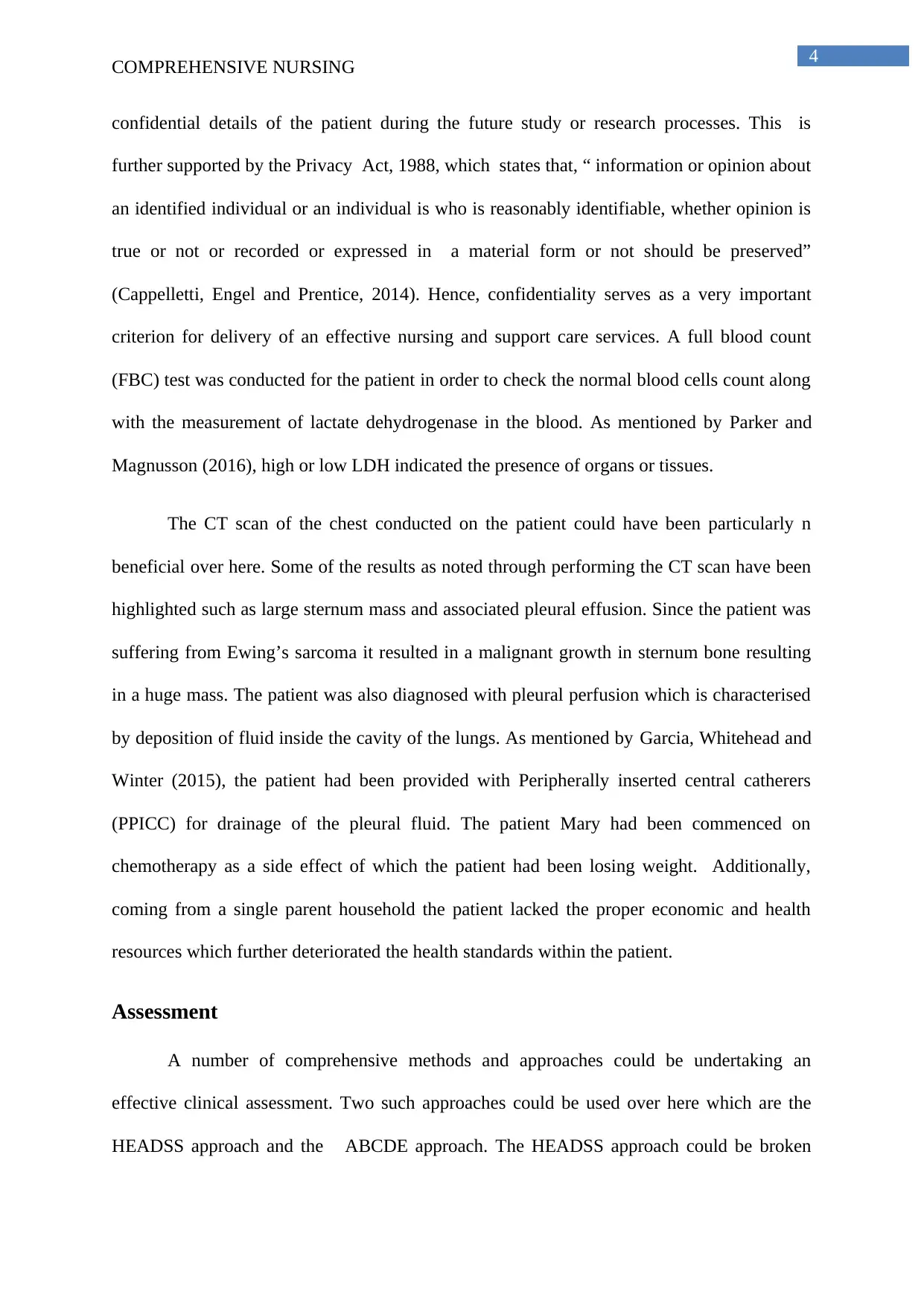
4
COMPREHENSIVE NURSING
confidential details of the patient during the future study or research processes. This is
further supported by the Privacy Act, 1988, which states that, “ information or opinion about
an identified individual or an individual is who is reasonably identifiable, whether opinion is
true or not or recorded or expressed in a material form or not should be preserved”
(Cappelletti, Engel and Prentice, 2014). Hence, confidentiality serves as a very important
criterion for delivery of an effective nursing and support care services. A full blood count
(FBC) test was conducted for the patient in order to check the normal blood cells count along
with the measurement of lactate dehydrogenase in the blood. As mentioned by Parker and
Magnusson (2016), high or low LDH indicated the presence of organs or tissues.
The CT scan of the chest conducted on the patient could have been particularly n
beneficial over here. Some of the results as noted through performing the CT scan have been
highlighted such as large sternum mass and associated pleural effusion. Since the patient was
suffering from Ewing’s sarcoma it resulted in a malignant growth in sternum bone resulting
in a huge mass. The patient was also diagnosed with pleural perfusion which is characterised
by deposition of fluid inside the cavity of the lungs. As mentioned by Garcia, Whitehead and
Winter (2015), the patient had been provided with Peripherally inserted central catherers
(PPICC) for drainage of the pleural fluid. The patient Mary had been commenced on
chemotherapy as a side effect of which the patient had been losing weight. Additionally,
coming from a single parent household the patient lacked the proper economic and health
resources which further deteriorated the health standards within the patient.
Assessment
A number of comprehensive methods and approaches could be undertaking an
effective clinical assessment. Two such approaches could be used over here which are the
HEADSS approach and the ABCDE approach. The HEADSS approach could be broken
COMPREHENSIVE NURSING
confidential details of the patient during the future study or research processes. This is
further supported by the Privacy Act, 1988, which states that, “ information or opinion about
an identified individual or an individual is who is reasonably identifiable, whether opinion is
true or not or recorded or expressed in a material form or not should be preserved”
(Cappelletti, Engel and Prentice, 2014). Hence, confidentiality serves as a very important
criterion for delivery of an effective nursing and support care services. A full blood count
(FBC) test was conducted for the patient in order to check the normal blood cells count along
with the measurement of lactate dehydrogenase in the blood. As mentioned by Parker and
Magnusson (2016), high or low LDH indicated the presence of organs or tissues.
The CT scan of the chest conducted on the patient could have been particularly n
beneficial over here. Some of the results as noted through performing the CT scan have been
highlighted such as large sternum mass and associated pleural effusion. Since the patient was
suffering from Ewing’s sarcoma it resulted in a malignant growth in sternum bone resulting
in a huge mass. The patient was also diagnosed with pleural perfusion which is characterised
by deposition of fluid inside the cavity of the lungs. As mentioned by Garcia, Whitehead and
Winter (2015), the patient had been provided with Peripherally inserted central catherers
(PPICC) for drainage of the pleural fluid. The patient Mary had been commenced on
chemotherapy as a side effect of which the patient had been losing weight. Additionally,
coming from a single parent household the patient lacked the proper economic and health
resources which further deteriorated the health standards within the patient.
Assessment
A number of comprehensive methods and approaches could be undertaking an
effective clinical assessment. Two such approaches could be used over here which are the
HEADSS approach and the ABCDE approach. The HEADSS approach could be broken
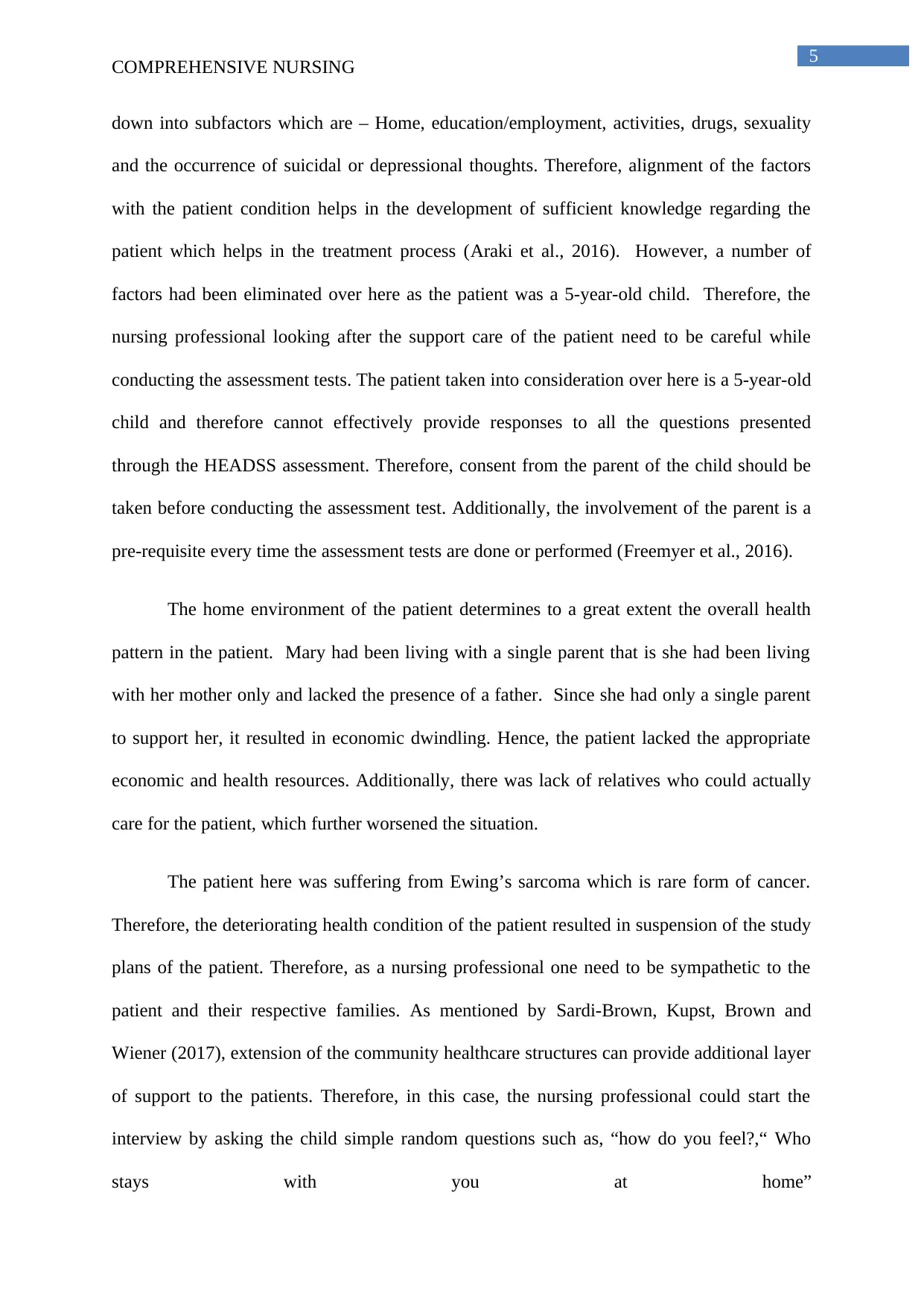
5
COMPREHENSIVE NURSING
down into subfactors which are – Home, education/employment, activities, drugs, sexuality
and the occurrence of suicidal or depressional thoughts. Therefore, alignment of the factors
with the patient condition helps in the development of sufficient knowledge regarding the
patient which helps in the treatment process (Araki et al., 2016). However, a number of
factors had been eliminated over here as the patient was a 5-year-old child. Therefore, the
nursing professional looking after the support care of the patient need to be careful while
conducting the assessment tests. The patient taken into consideration over here is a 5-year-old
child and therefore cannot effectively provide responses to all the questions presented
through the HEADSS assessment. Therefore, consent from the parent of the child should be
taken before conducting the assessment test. Additionally, the involvement of the parent is a
pre-requisite every time the assessment tests are done or performed (Freemyer et al., 2016).
The home environment of the patient determines to a great extent the overall health
pattern in the patient. Mary had been living with a single parent that is she had been living
with her mother only and lacked the presence of a father. Since she had only a single parent
to support her, it resulted in economic dwindling. Hence, the patient lacked the appropriate
economic and health resources. Additionally, there was lack of relatives who could actually
care for the patient, which further worsened the situation.
The patient here was suffering from Ewing’s sarcoma which is rare form of cancer.
Therefore, the deteriorating health condition of the patient resulted in suspension of the study
plans of the patient. Therefore, as a nursing professional one need to be sympathetic to the
patient and their respective families. As mentioned by Sardi-Brown, Kupst, Brown and
Wiener (2017), extension of the community healthcare structures can provide additional layer
of support to the patients. Therefore, in this case, the nursing professional could start the
interview by asking the child simple random questions such as, “how do you feel?,“ Who
stays with you at home”
COMPREHENSIVE NURSING
down into subfactors which are – Home, education/employment, activities, drugs, sexuality
and the occurrence of suicidal or depressional thoughts. Therefore, alignment of the factors
with the patient condition helps in the development of sufficient knowledge regarding the
patient which helps in the treatment process (Araki et al., 2016). However, a number of
factors had been eliminated over here as the patient was a 5-year-old child. Therefore, the
nursing professional looking after the support care of the patient need to be careful while
conducting the assessment tests. The patient taken into consideration over here is a 5-year-old
child and therefore cannot effectively provide responses to all the questions presented
through the HEADSS assessment. Therefore, consent from the parent of the child should be
taken before conducting the assessment test. Additionally, the involvement of the parent is a
pre-requisite every time the assessment tests are done or performed (Freemyer et al., 2016).
The home environment of the patient determines to a great extent the overall health
pattern in the patient. Mary had been living with a single parent that is she had been living
with her mother only and lacked the presence of a father. Since she had only a single parent
to support her, it resulted in economic dwindling. Hence, the patient lacked the appropriate
economic and health resources. Additionally, there was lack of relatives who could actually
care for the patient, which further worsened the situation.
The patient here was suffering from Ewing’s sarcoma which is rare form of cancer.
Therefore, the deteriorating health condition of the patient resulted in suspension of the study
plans of the patient. Therefore, as a nursing professional one need to be sympathetic to the
patient and their respective families. As mentioned by Sardi-Brown, Kupst, Brown and
Wiener (2017), extension of the community healthcare structures can provide additional layer
of support to the patients. Therefore, in this case, the nursing professional could start the
interview by asking the child simple random questions such as, “how do you feel?,“ Who
stays with you at home”
⊘ This is a preview!⊘
Do you want full access?
Subscribe today to unlock all pages.

Trusted by 1+ million students worldwide
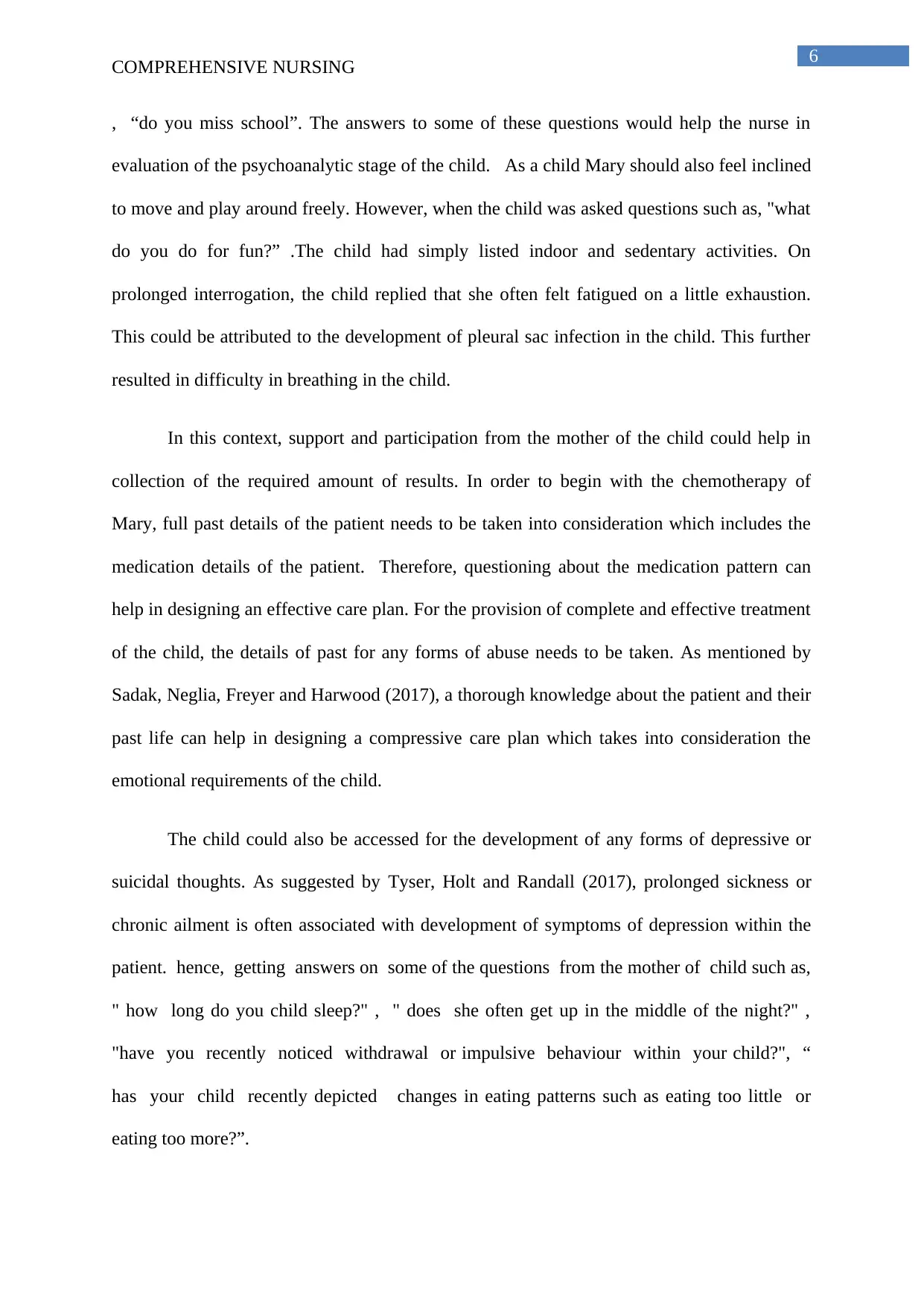
6
COMPREHENSIVE NURSING
, “do you miss school”. The answers to some of these questions would help the nurse in
evaluation of the psychoanalytic stage of the child. As a child Mary should also feel inclined
to move and play around freely. However, when the child was asked questions such as, "what
do you do for fun?” .The child had simply listed indoor and sedentary activities. On
prolonged interrogation, the child replied that she often felt fatigued on a little exhaustion.
This could be attributed to the development of pleural sac infection in the child. This further
resulted in difficulty in breathing in the child.
In this context, support and participation from the mother of the child could help in
collection of the required amount of results. In order to begin with the chemotherapy of
Mary, full past details of the patient needs to be taken into consideration which includes the
medication details of the patient. Therefore, questioning about the medication pattern can
help in designing an effective care plan. For the provision of complete and effective treatment
of the child, the details of past for any forms of abuse needs to be taken. As mentioned by
Sadak, Neglia, Freyer and Harwood (2017), a thorough knowledge about the patient and their
past life can help in designing a compressive care plan which takes into consideration the
emotional requirements of the child.
The child could also be accessed for the development of any forms of depressive or
suicidal thoughts. As suggested by Tyser, Holt and Randall (2017), prolonged sickness or
chronic ailment is often associated with development of symptoms of depression within the
patient. hence, getting answers on some of the questions from the mother of child such as,
" how long do you child sleep?" , " does she often get up in the middle of the night?" ,
"have you recently noticed withdrawal or impulsive behaviour within your child?", “
has your child recently depicted changes in eating patterns such as eating too little or
eating too more?”.
COMPREHENSIVE NURSING
, “do you miss school”. The answers to some of these questions would help the nurse in
evaluation of the psychoanalytic stage of the child. As a child Mary should also feel inclined
to move and play around freely. However, when the child was asked questions such as, "what
do you do for fun?” .The child had simply listed indoor and sedentary activities. On
prolonged interrogation, the child replied that she often felt fatigued on a little exhaustion.
This could be attributed to the development of pleural sac infection in the child. This further
resulted in difficulty in breathing in the child.
In this context, support and participation from the mother of the child could help in
collection of the required amount of results. In order to begin with the chemotherapy of
Mary, full past details of the patient needs to be taken into consideration which includes the
medication details of the patient. Therefore, questioning about the medication pattern can
help in designing an effective care plan. For the provision of complete and effective treatment
of the child, the details of past for any forms of abuse needs to be taken. As mentioned by
Sadak, Neglia, Freyer and Harwood (2017), a thorough knowledge about the patient and their
past life can help in designing a compressive care plan which takes into consideration the
emotional requirements of the child.
The child could also be accessed for the development of any forms of depressive or
suicidal thoughts. As suggested by Tyser, Holt and Randall (2017), prolonged sickness or
chronic ailment is often associated with development of symptoms of depression within the
patient. hence, getting answers on some of the questions from the mother of child such as,
" how long do you child sleep?" , " does she often get up in the middle of the night?" ,
"have you recently noticed withdrawal or impulsive behaviour within your child?", “
has your child recently depicted changes in eating patterns such as eating too little or
eating too more?”.
Paraphrase This Document
Need a fresh take? Get an instant paraphrase of this document with our AI Paraphraser
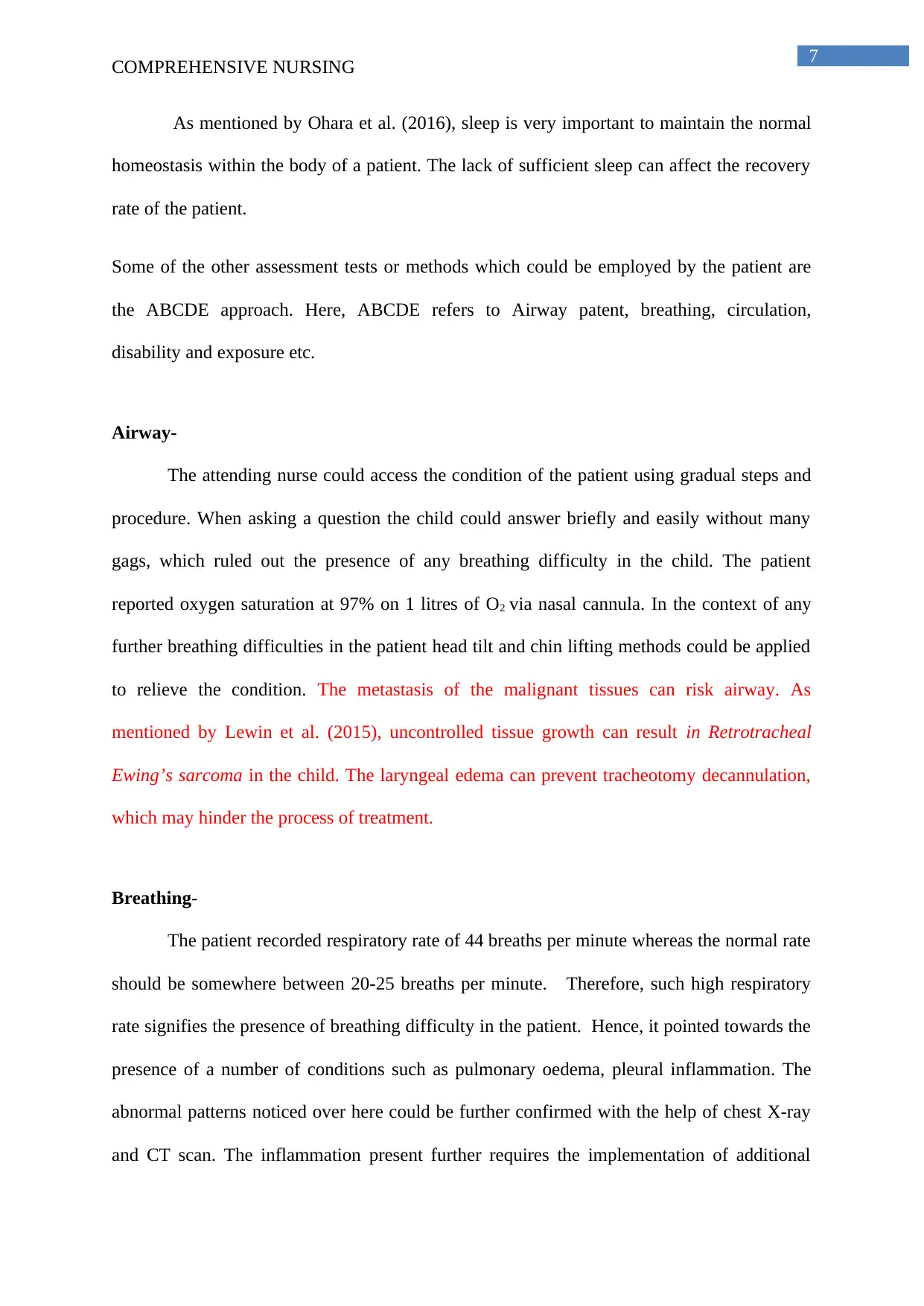
7
COMPREHENSIVE NURSING
As mentioned by Ohara et al. (2016), sleep is very important to maintain the normal
homeostasis within the body of a patient. The lack of sufficient sleep can affect the recovery
rate of the patient.
Some of the other assessment tests or methods which could be employed by the patient are
the ABCDE approach. Here, ABCDE refers to Airway patent, breathing, circulation,
disability and exposure etc.
Airway-
The attending nurse could access the condition of the patient using gradual steps and
procedure. When asking a question the child could answer briefly and easily without many
gags, which ruled out the presence of any breathing difficulty in the child. The patient
reported oxygen saturation at 97% on 1 litres of O2 via nasal cannula. In the context of any
further breathing difficulties in the patient head tilt and chin lifting methods could be applied
to relieve the condition. The metastasis of the malignant tissues can risk airway. As
mentioned by Lewin et al. (2015), uncontrolled tissue growth can result in Retrotracheal
Ewing’s sarcoma in the child. The laryngeal edema can prevent tracheotomy decannulation,
which may hinder the process of treatment.
Breathing-
The patient recorded respiratory rate of 44 breaths per minute whereas the normal rate
should be somewhere between 20-25 breaths per minute. Therefore, such high respiratory
rate signifies the presence of breathing difficulty in the patient. Hence, it pointed towards the
presence of a number of conditions such as pulmonary oedema, pleural inflammation. The
abnormal patterns noticed over here could be further confirmed with the help of chest X-ray
and CT scan. The inflammation present further requires the implementation of additional
COMPREHENSIVE NURSING
As mentioned by Ohara et al. (2016), sleep is very important to maintain the normal
homeostasis within the body of a patient. The lack of sufficient sleep can affect the recovery
rate of the patient.
Some of the other assessment tests or methods which could be employed by the patient are
the ABCDE approach. Here, ABCDE refers to Airway patent, breathing, circulation,
disability and exposure etc.
Airway-
The attending nurse could access the condition of the patient using gradual steps and
procedure. When asking a question the child could answer briefly and easily without many
gags, which ruled out the presence of any breathing difficulty in the child. The patient
reported oxygen saturation at 97% on 1 litres of O2 via nasal cannula. In the context of any
further breathing difficulties in the patient head tilt and chin lifting methods could be applied
to relieve the condition. The metastasis of the malignant tissues can risk airway. As
mentioned by Lewin et al. (2015), uncontrolled tissue growth can result in Retrotracheal
Ewing’s sarcoma in the child. The laryngeal edema can prevent tracheotomy decannulation,
which may hinder the process of treatment.
Breathing-
The patient recorded respiratory rate of 44 breaths per minute whereas the normal rate
should be somewhere between 20-25 breaths per minute. Therefore, such high respiratory
rate signifies the presence of breathing difficulty in the patient. Hence, it pointed towards the
presence of a number of conditions such as pulmonary oedema, pleural inflammation. The
abnormal patterns noticed over here could be further confirmed with the help of chest X-ray
and CT scan. The inflammation present further requires the implementation of additional
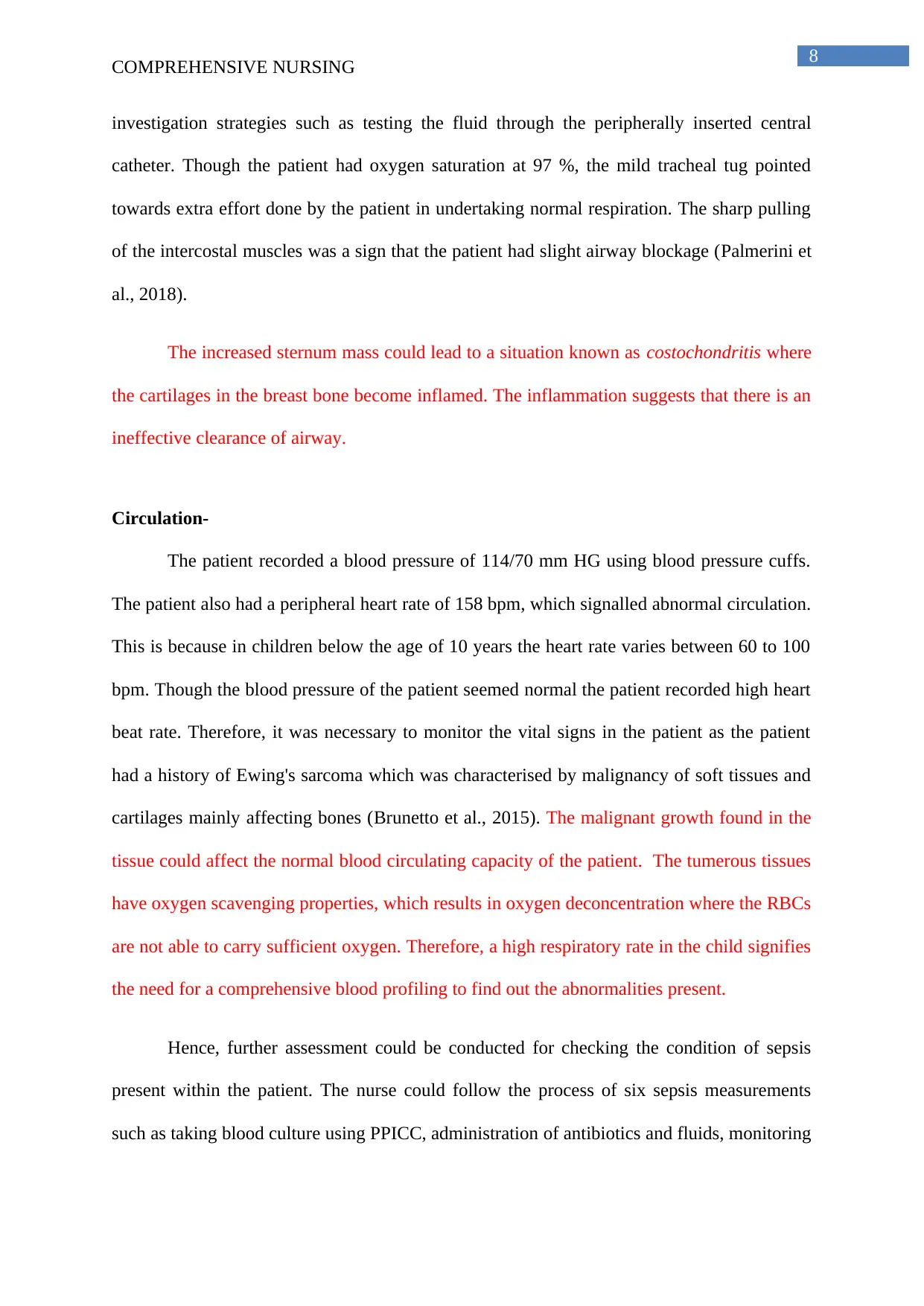
8
COMPREHENSIVE NURSING
investigation strategies such as testing the fluid through the peripherally inserted central
catheter. Though the patient had oxygen saturation at 97 %, the mild tracheal tug pointed
towards extra effort done by the patient in undertaking normal respiration. The sharp pulling
of the intercostal muscles was a sign that the patient had slight airway blockage (Palmerini et
al., 2018).
The increased sternum mass could lead to a situation known as costochondritis where
the cartilages in the breast bone become inflamed. The inflammation suggests that there is an
ineffective clearance of airway.
Circulation-
The patient recorded a blood pressure of 114/70 mm HG using blood pressure cuffs.
The patient also had a peripheral heart rate of 158 bpm, which signalled abnormal circulation.
This is because in children below the age of 10 years the heart rate varies between 60 to 100
bpm. Though the blood pressure of the patient seemed normal the patient recorded high heart
beat rate. Therefore, it was necessary to monitor the vital signs in the patient as the patient
had a history of Ewing's sarcoma which was characterised by malignancy of soft tissues and
cartilages mainly affecting bones (Brunetto et al., 2015). The malignant growth found in the
tissue could affect the normal blood circulating capacity of the patient. The tumerous tissues
have oxygen scavenging properties, which results in oxygen deconcentration where the RBCs
are not able to carry sufficient oxygen. Therefore, a high respiratory rate in the child signifies
the need for a comprehensive blood profiling to find out the abnormalities present.
Hence, further assessment could be conducted for checking the condition of sepsis
present within the patient. The nurse could follow the process of six sepsis measurements
such as taking blood culture using PPICC, administration of antibiotics and fluids, monitoring
COMPREHENSIVE NURSING
investigation strategies such as testing the fluid through the peripherally inserted central
catheter. Though the patient had oxygen saturation at 97 %, the mild tracheal tug pointed
towards extra effort done by the patient in undertaking normal respiration. The sharp pulling
of the intercostal muscles was a sign that the patient had slight airway blockage (Palmerini et
al., 2018).
The increased sternum mass could lead to a situation known as costochondritis where
the cartilages in the breast bone become inflamed. The inflammation suggests that there is an
ineffective clearance of airway.
Circulation-
The patient recorded a blood pressure of 114/70 mm HG using blood pressure cuffs.
The patient also had a peripheral heart rate of 158 bpm, which signalled abnormal circulation.
This is because in children below the age of 10 years the heart rate varies between 60 to 100
bpm. Though the blood pressure of the patient seemed normal the patient recorded high heart
beat rate. Therefore, it was necessary to monitor the vital signs in the patient as the patient
had a history of Ewing's sarcoma which was characterised by malignancy of soft tissues and
cartilages mainly affecting bones (Brunetto et al., 2015). The malignant growth found in the
tissue could affect the normal blood circulating capacity of the patient. The tumerous tissues
have oxygen scavenging properties, which results in oxygen deconcentration where the RBCs
are not able to carry sufficient oxygen. Therefore, a high respiratory rate in the child signifies
the need for a comprehensive blood profiling to find out the abnormalities present.
Hence, further assessment could be conducted for checking the condition of sepsis
present within the patient. The nurse could follow the process of six sepsis measurements
such as taking blood culture using PPICC, administration of antibiotics and fluids, monitoring
⊘ This is a preview!⊘
Do you want full access?
Subscribe today to unlock all pages.

Trusted by 1+ million students worldwide
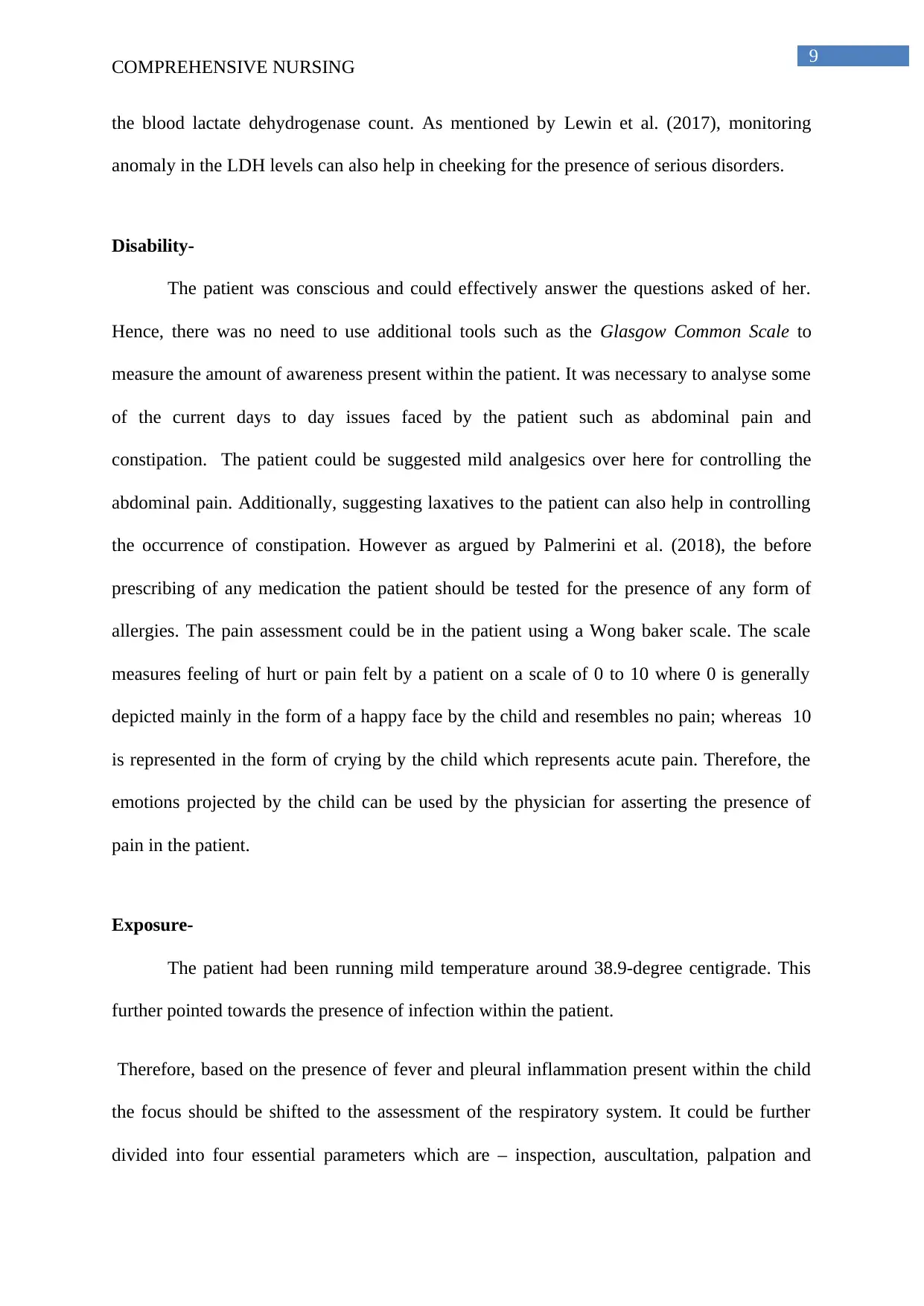
9
COMPREHENSIVE NURSING
the blood lactate dehydrogenase count. As mentioned by Lewin et al. (2017), monitoring
anomaly in the LDH levels can also help in cheeking for the presence of serious disorders.
Disability-
The patient was conscious and could effectively answer the questions asked of her.
Hence, there was no need to use additional tools such as the Glasgow Common Scale to
measure the amount of awareness present within the patient. It was necessary to analyse some
of the current days to day issues faced by the patient such as abdominal pain and
constipation. The patient could be suggested mild analgesics over here for controlling the
abdominal pain. Additionally, suggesting laxatives to the patient can also help in controlling
the occurrence of constipation. However as argued by Palmerini et al. (2018), the before
prescribing of any medication the patient should be tested for the presence of any form of
allergies. The pain assessment could be in the patient using a Wong baker scale. The scale
measures feeling of hurt or pain felt by a patient on a scale of 0 to 10 where 0 is generally
depicted mainly in the form of a happy face by the child and resembles no pain; whereas 10
is represented in the form of crying by the child which represents acute pain. Therefore, the
emotions projected by the child can be used by the physician for asserting the presence of
pain in the patient.
Exposure-
The patient had been running mild temperature around 38.9-degree centigrade. This
further pointed towards the presence of infection within the patient.
Therefore, based on the presence of fever and pleural inflammation present within the child
the focus should be shifted to the assessment of the respiratory system. It could be further
divided into four essential parameters which are – inspection, auscultation, palpation and
COMPREHENSIVE NURSING
the blood lactate dehydrogenase count. As mentioned by Lewin et al. (2017), monitoring
anomaly in the LDH levels can also help in cheeking for the presence of serious disorders.
Disability-
The patient was conscious and could effectively answer the questions asked of her.
Hence, there was no need to use additional tools such as the Glasgow Common Scale to
measure the amount of awareness present within the patient. It was necessary to analyse some
of the current days to day issues faced by the patient such as abdominal pain and
constipation. The patient could be suggested mild analgesics over here for controlling the
abdominal pain. Additionally, suggesting laxatives to the patient can also help in controlling
the occurrence of constipation. However as argued by Palmerini et al. (2018), the before
prescribing of any medication the patient should be tested for the presence of any form of
allergies. The pain assessment could be in the patient using a Wong baker scale. The scale
measures feeling of hurt or pain felt by a patient on a scale of 0 to 10 where 0 is generally
depicted mainly in the form of a happy face by the child and resembles no pain; whereas 10
is represented in the form of crying by the child which represents acute pain. Therefore, the
emotions projected by the child can be used by the physician for asserting the presence of
pain in the patient.
Exposure-
The patient had been running mild temperature around 38.9-degree centigrade. This
further pointed towards the presence of infection within the patient.
Therefore, based on the presence of fever and pleural inflammation present within the child
the focus should be shifted to the assessment of the respiratory system. It could be further
divided into four essential parameters which are – inspection, auscultation, palpation and
Paraphrase This Document
Need a fresh take? Get an instant paraphrase of this document with our AI Paraphraser
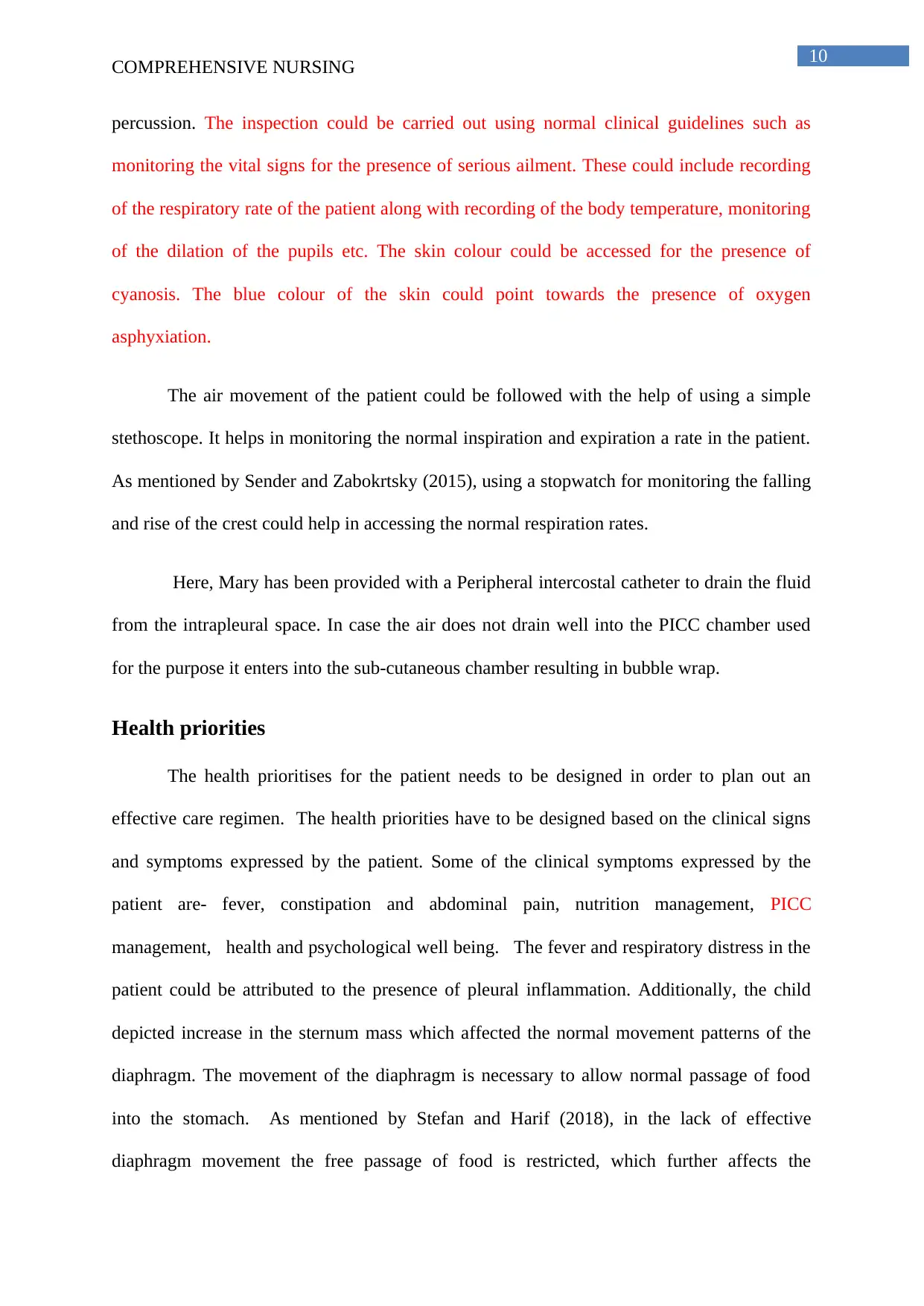
10
COMPREHENSIVE NURSING
percussion. The inspection could be carried out using normal clinical guidelines such as
monitoring the vital signs for the presence of serious ailment. These could include recording
of the respiratory rate of the patient along with recording of the body temperature, monitoring
of the dilation of the pupils etc. The skin colour could be accessed for the presence of
cyanosis. The blue colour of the skin could point towards the presence of oxygen
asphyxiation.
The air movement of the patient could be followed with the help of using a simple
stethoscope. It helps in monitoring the normal inspiration and expiration a rate in the patient.
As mentioned by Sender and Zabokrtsky (2015), using a stopwatch for monitoring the falling
and rise of the crest could help in accessing the normal respiration rates.
Here, Mary has been provided with a Peripheral intercostal catheter to drain the fluid
from the intrapleural space. In case the air does not drain well into the PICC chamber used
for the purpose it enters into the sub-cutaneous chamber resulting in bubble wrap.
Health priorities
The health prioritises for the patient needs to be designed in order to plan out an
effective care regimen. The health priorities have to be designed based on the clinical signs
and symptoms expressed by the patient. Some of the clinical symptoms expressed by the
patient are- fever, constipation and abdominal pain, nutrition management, PICC
management, health and psychological well being. The fever and respiratory distress in the
patient could be attributed to the presence of pleural inflammation. Additionally, the child
depicted increase in the sternum mass which affected the normal movement patterns of the
diaphragm. The movement of the diaphragm is necessary to allow normal passage of food
into the stomach. As mentioned by Stefan and Harif (2018), in the lack of effective
diaphragm movement the free passage of food is restricted, which further affects the
COMPREHENSIVE NURSING
percussion. The inspection could be carried out using normal clinical guidelines such as
monitoring the vital signs for the presence of serious ailment. These could include recording
of the respiratory rate of the patient along with recording of the body temperature, monitoring
of the dilation of the pupils etc. The skin colour could be accessed for the presence of
cyanosis. The blue colour of the skin could point towards the presence of oxygen
asphyxiation.
The air movement of the patient could be followed with the help of using a simple
stethoscope. It helps in monitoring the normal inspiration and expiration a rate in the patient.
As mentioned by Sender and Zabokrtsky (2015), using a stopwatch for monitoring the falling
and rise of the crest could help in accessing the normal respiration rates.
Here, Mary has been provided with a Peripheral intercostal catheter to drain the fluid
from the intrapleural space. In case the air does not drain well into the PICC chamber used
for the purpose it enters into the sub-cutaneous chamber resulting in bubble wrap.
Health priorities
The health prioritises for the patient needs to be designed in order to plan out an
effective care regimen. The health priorities have to be designed based on the clinical signs
and symptoms expressed by the patient. Some of the clinical symptoms expressed by the
patient are- fever, constipation and abdominal pain, nutrition management, PICC
management, health and psychological well being. The fever and respiratory distress in the
patient could be attributed to the presence of pleural inflammation. Additionally, the child
depicted increase in the sternum mass which affected the normal movement patterns of the
diaphragm. The movement of the diaphragm is necessary to allow normal passage of food
into the stomach. As mentioned by Stefan and Harif (2018), in the lack of effective
diaphragm movement the free passage of food is restricted, which further affects the
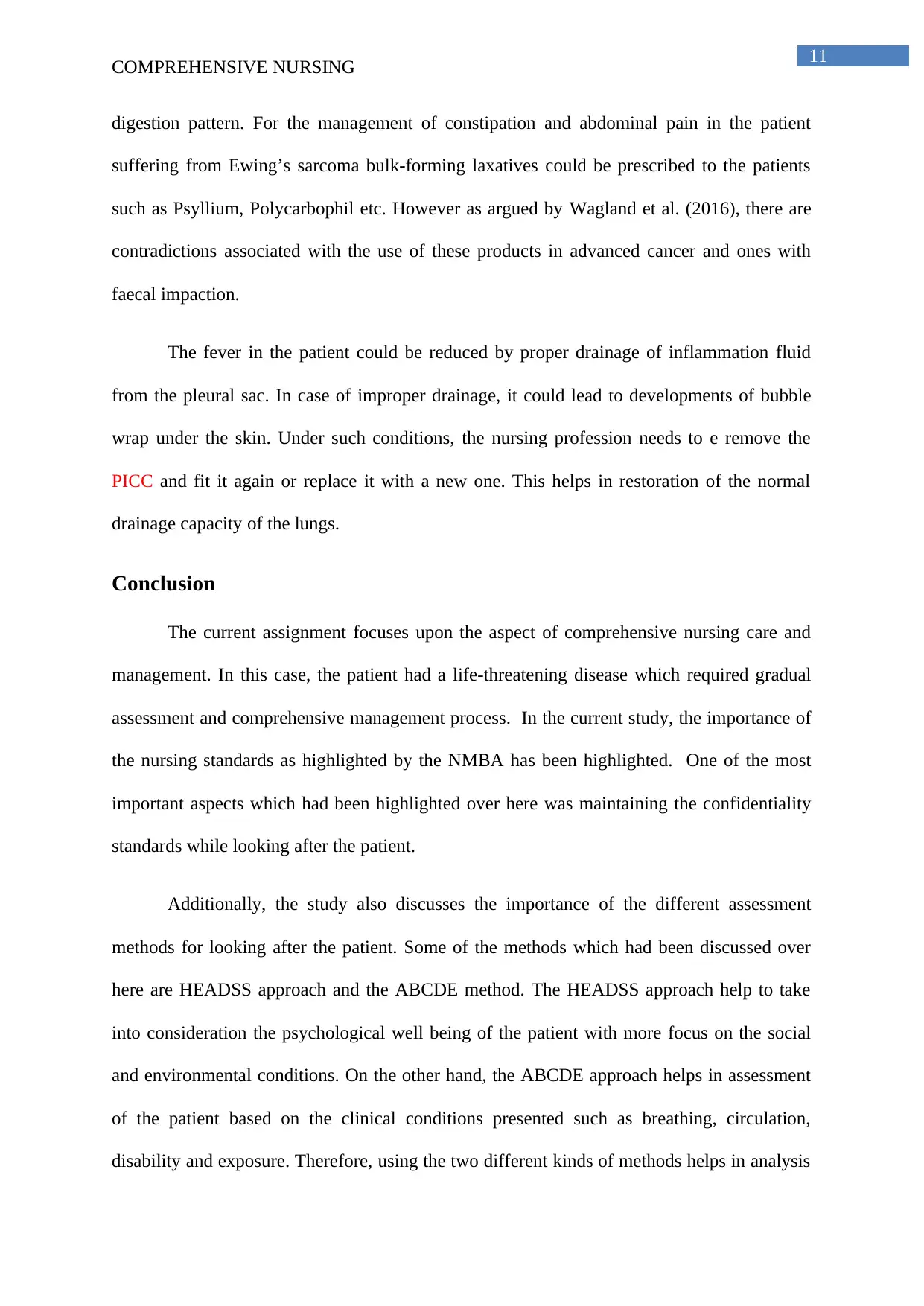
11
COMPREHENSIVE NURSING
digestion pattern. For the management of constipation and abdominal pain in the patient
suffering from Ewing’s sarcoma bulk-forming laxatives could be prescribed to the patients
such as Psyllium, Polycarbophil etc. However as argued by Wagland et al. (2016), there are
contradictions associated with the use of these products in advanced cancer and ones with
faecal impaction.
The fever in the patient could be reduced by proper drainage of inflammation fluid
from the pleural sac. In case of improper drainage, it could lead to developments of bubble
wrap under the skin. Under such conditions, the nursing profession needs to e remove the
PICC and fit it again or replace it with a new one. This helps in restoration of the normal
drainage capacity of the lungs.
Conclusion
The current assignment focuses upon the aspect of comprehensive nursing care and
management. In this case, the patient had a life-threatening disease which required gradual
assessment and comprehensive management process. In the current study, the importance of
the nursing standards as highlighted by the NMBA has been highlighted. One of the most
important aspects which had been highlighted over here was maintaining the confidentiality
standards while looking after the patient.
Additionally, the study also discusses the importance of the different assessment
methods for looking after the patient. Some of the methods which had been discussed over
here are HEADSS approach and the ABCDE method. The HEADSS approach help to take
into consideration the psychological well being of the patient with more focus on the social
and environmental conditions. On the other hand, the ABCDE approach helps in assessment
of the patient based on the clinical conditions presented such as breathing, circulation,
disability and exposure. Therefore, using the two different kinds of methods helps in analysis
COMPREHENSIVE NURSING
digestion pattern. For the management of constipation and abdominal pain in the patient
suffering from Ewing’s sarcoma bulk-forming laxatives could be prescribed to the patients
such as Psyllium, Polycarbophil etc. However as argued by Wagland et al. (2016), there are
contradictions associated with the use of these products in advanced cancer and ones with
faecal impaction.
The fever in the patient could be reduced by proper drainage of inflammation fluid
from the pleural sac. In case of improper drainage, it could lead to developments of bubble
wrap under the skin. Under such conditions, the nursing profession needs to e remove the
PICC and fit it again or replace it with a new one. This helps in restoration of the normal
drainage capacity of the lungs.
Conclusion
The current assignment focuses upon the aspect of comprehensive nursing care and
management. In this case, the patient had a life-threatening disease which required gradual
assessment and comprehensive management process. In the current study, the importance of
the nursing standards as highlighted by the NMBA has been highlighted. One of the most
important aspects which had been highlighted over here was maintaining the confidentiality
standards while looking after the patient.
Additionally, the study also discusses the importance of the different assessment
methods for looking after the patient. Some of the methods which had been discussed over
here are HEADSS approach and the ABCDE method. The HEADSS approach help to take
into consideration the psychological well being of the patient with more focus on the social
and environmental conditions. On the other hand, the ABCDE approach helps in assessment
of the patient based on the clinical conditions presented such as breathing, circulation,
disability and exposure. Therefore, using the two different kinds of methods helps in analysis
⊘ This is a preview!⊘
Do you want full access?
Subscribe today to unlock all pages.

Trusted by 1+ million students worldwide
1 out of 17
Related Documents
Your All-in-One AI-Powered Toolkit for Academic Success.
+13062052269
info@desklib.com
Available 24*7 on WhatsApp / Email
![[object Object]](/_next/static/media/star-bottom.7253800d.svg)
Unlock your academic potential
Copyright © 2020–2025 A2Z Services. All Rights Reserved. Developed and managed by ZUCOL.





